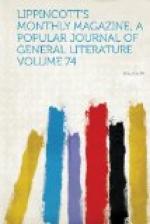Now, like the “goosie gander” of nursery memory, we must wander again into the lady’s chamber. Were you to wander to such a place after a Japanese maiden became a wife, you would see, as we have often seen, how the outward form of a Japanese maiden assumes that of a Japanese matron. First, then, the maiden wears a high coiffure that always serves as a sacred symbol of her virginity. It is not easy to describe its form, but even foreigners think it very beautiful, and will regret the day when the Japanese musume wears her hair like her sisters across the ocean. Indeed, it would be no strange thing were Queen Fashion to ordain that American maidens should adopt the style of dressing the hair now in universal vogue in Japan. The shimada or virginal coiffure, however, is changed after marriage, and Kiku, like the rest of her wedded friends, now wore the maru-mage, or half-moon-shaped chignon, which is wound round an ivory, tortoise-shell or coral-tipped bar, and is the distinguishing mark of a Japanese wife. So far, however, the transition from loveliness to ugliness has not been very startling: Kiku still looked pretty. The second process, however, robbed her of her eyebrows, and left her without those dark arches that had helped to make the radiant sun of her once maidenly beauty. With tweezers and razor the fell work, after many a wince, was done. With denuded brows and changed coiffure surely the Japanese Hymen demands no more sacrifices at his shrine? Surely Kiku can still keep the treasures of a set of teeth that seem like a casket of pearls with borders of coral? Not so. The fashion of all good society from remotest antiquity demands that the teeth of a wife must be dyed black. Kiku joyfully applied the galls and iron, and by patience and dint of polishing soon had a set of teeth as black as jet and as polished as the best Whitby. Not strange to tell to a Japanese, either, the smile of her husband Taro was a rich reward for her trouble and the surrender of her maiden charms. Japanese husbands never kiss their wives: kissing is an art unknown in Japan. It is even doubtful whether the language has a word signifying a kiss. No wonder Young Japan wishes to change his language for the English! Henceforth in public or private, alone or in company, Kiku’s personal and social safety was as secure as if clothed in armor of proof and attended by an army. The black teeth, maru-mage and shaven eyebrows constitute a talisman of safety in a land which foreigners so like to believe licentious and corrupt beyond the bounds of conception.




